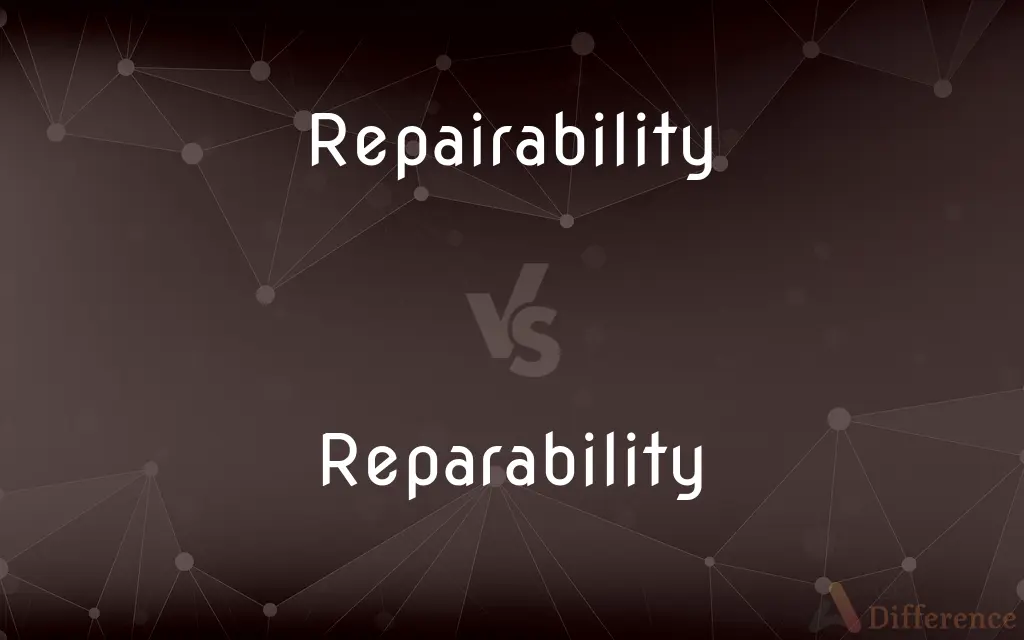Repairability vs. Reparability — What's the Difference?
Edited by Tayyaba Rehman — By Urooj Arif — Updated on March 30, 2024
Repairability refers to how easily something can be fixed or restored to its original condition, focusing on the practical aspects of repair. Reparability is less commonly used but essentially carries the same meaning as repairability.

Difference Between Repairability and Reparability
Table of Contents
ADVERTISEMENT
Key Differences
Repairability is a term commonly used in contexts ranging from consumer electronics to automobiles, indicating the ease with which a product can be repaired. Factors influencing repairability include the availability of spare parts, the complexity of the design, and the need for specialized tools or skills. A product with high repairability is often seen as more sustainable and cost-effective over its lifespan. In contrast, reparability is less frequently used in everyday language but serves as an alternative to repairability, conveying the same concept of how feasibly something can be repaired or mended.
In discussions about product design, environmental sustainability, and consumer rights, repairability is increasingly emphasized. It represents a critical aspect of product assessment, with some advocating for right-to-repair laws that ensure products are made to be easily repairable, thereby extending their usability and reducing waste. Whereas reparability, while interchangeable with repairability in meaning, is not as prominently featured in these conversations, possibly due to the more widespread adoption of the term repairability in technical and consumer-focused discourse.
The choice between using repairability and reparability might depend on regional preferences, specific industry jargon, or even the preference of the speaker or writer. However, repairability is more likely to be understood and recognized across a broader audience, given its prevalence in discussions related to technology, sustainability, and consumer advocacy.
Both terms underscore the importance of designing products that can be easily maintained and repaired, challenging the trend towards planned obsolescence where products are designed to have a limited lifespan. This emphasis on repairability (or reparability) supports environmental conservation efforts by promoting the reuse and longevity of products, reducing the need for frequent replacements and minimizing waste.
Ultimately, while repairability is the more commonly utilized term, both it and reparability highlight the crucial aspect of product design and use that affects sustainability, cost-effectiveness, and consumer satisfaction. The push towards greater repairability in products is part of a larger movement towards sustainability and environmental responsibility.
ADVERTISEMENT
Comparison Chart
Definition
Ease with which something can be repaired or restored.
Essentially the same as repairability; less commonly used.
Usage Context
Commonly used in technology, automotive, sustainability.
Less frequently used, interchangeable with repairability.
Focus
Practical aspects of repair, including availability of parts, design complexity.
Same focus as repairability; alternative term.
Significance
Prominent in discussions on sustainability, consumer rights.
Same significance; less prevalent in specific discourse.
Industry Relevance
Highly relevant in industries aiming for sustainability and long-term use.
Same relevance, though less commonly cited in industry discussions.
Compare with Definitions
Repairability
Measure of ease in fixing products.
The smartphone's repairability score was high, making it easy for users to replace the screen.
Reparability
Synonym for repairability, indicating how easily something can be fixed.
The appliance's reparability was a major selling point, as parts were readily available and affordable.
Repairability
Related to sustainability and cost savings.
Products with high repairability are preferred for their environmental and economic benefits.
Reparability
Can be considered in environmental policies.
Government regulations on product reparability could enforce more sustainable manufacturing practices.
Repairability
Critical in right-to-repair advocacy.
Advocates argue that repairability should be a key consideration in product design.
Reparability
Impacts product lifespan and waste reduction.
Focusing on reparability can significantly extend the life of household items and reduce waste.
Repairability
Influenced by design and availability of parts.
A car's repairability is often determined by how easily mechanics can access and replace parts.
Reparability
Reflects on the ability to mend or restore.
The building's reparability after the earthquake was uncertain due to structural damage.
Repairability
Assessed in product reviews and guides.
Online guides often rate electronic devices based on their repairability.
Reparability
Occasionally used in legal or formal contexts.
The contract specified the reparability of the equipment as a condition of the lease.
Repairability
To restore to sound condition after damage or injury; fix
Repaired the broken watch.
Reparability
Possible to repair
Reparable damage to the car.
Reparable wrongs.
Repairability
To set right; remedy
Repair an oversight.
Reparability
Alternative form of repairability
Repairability
To restore or renew
Repair the immune system.
Reparability
The quality or state of being reparable.
Repairability
To make up for or compensate for (a loss or wrong, for example).
Repairability
To make repairs.
Repairability
The work, act, or process of repairing.
Repairability
Often repairs An instance or a result of repairing
The accident resulted in a costly repair to the car. My bike is in the shop for repairs.
Repairability
The state of being fit for use
The furnace is out of repair.
Repairability
General condition after use or repairing
In good repair.
Repairability
The property of being repairable.
Common Curiosities
How does reparability differ from repairability?
Reparability is essentially the same in meaning as repairability but is less commonly used.
What is repairability?
It's the ease with which a product or item can be repaired or restored to its original condition.
Can all products be designed with high repairability?
While challenging, designing for repairability is possible with thoughtful consideration of materials, construction, and assembly processes.
Are manufacturers required to make their products repairable?
While not universally required, there is growing pressure and legislative action in some regions to mandate repairability standards.
Is there a legal aspect to repairability?
Yes, the right-to-repair movement seeks legal measures to ensure products are designed to be repairable, countering planned obsolescence.
Why is repairability important?
It influences the sustainability, cost-effectiveness, and overall lifespan of products.
How are repairability scores determined for electronics?
Scores are typically based on factors like ease of disassembly, availability of repair manuals, and the availability and cost of replacement parts.
How does repairability affect consumer rights?
Higher repairability empowers consumers to maintain and repair their products, rather than being forced to replace them prematurely.
What role does repairability play in sustainability?
It reduces waste and resource consumption by extending the usable life of products, aligning with principles of environmental sustainability.
How can consumers advocate for higher repairability?
By supporting legislation for the right to repair, choosing products with higher repairability scores, and demanding more sustainable products from manufacturers.
Share Your Discovery

Previous Comparison
Escalator vs. Ramp
Next Comparison
Curette vs. CuvetteAuthor Spotlight
Written by
Urooj ArifUrooj is a skilled content writer at Ask Difference, known for her exceptional ability to simplify complex topics into engaging and informative content. With a passion for research and a flair for clear, concise writing, she consistently delivers articles that resonate with our diverse audience.
Edited by
Tayyaba RehmanTayyaba Rehman is a distinguished writer, currently serving as a primary contributor to askdifference.com. As a researcher in semantics and etymology, Tayyaba's passion for the complexity of languages and their distinctions has found a perfect home on the platform. Tayyaba delves into the intricacies of language, distinguishing between commonly confused words and phrases, thereby providing clarity for readers worldwide.













































